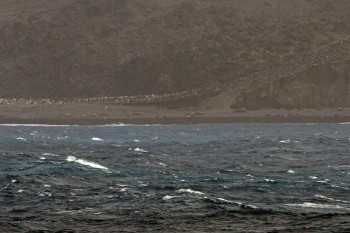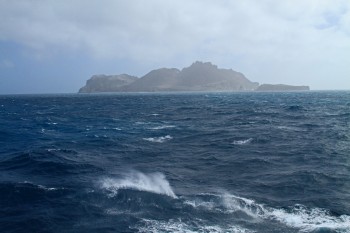
McDonald Island in November 2012
Along with Heard Island, some 44 km to the east, the McDonald Islands (including Meyer Rock, a 148-m unvegetated rocky spire roughly one kilometre to the north-west) are an Australian Commonwealth Marine Reserve (which includes surrounding waters extending in some directions to the Exclusive Economic Zone boundary) established in 2002. The island group has been a World Heritage Site (which includes its territorial waters) since 1997. In terms of the Heard Island and McDonald Islands 2005 management plan the latter islands fall within a Restricted Zone to afford them “the highest level of protection to maintain their undisturbed state. Entry and access to such areas will therefore be restricted and tightly controlled.”
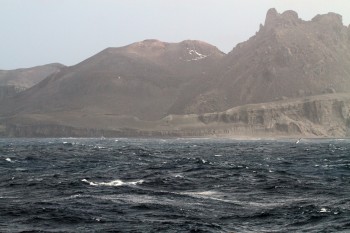
New volcanic domes and spires
McDonald Island is known to have been landed on only twice. On 27 January 1971 an Alouette helicopter from the m.s. Gallieni landed a French and an Australian scientist for only 45 minutes ashore. In March 1980 a six-person team from the Australian Antarctic Division and the then Australian Department of National Development and Energy made landings by sea and helicopter on McDonald and Flat Islands, spending four days ashore to undertake mapping and scientific surveys, with a helicopter-borne survey made of Meyer Rock. Since then all observations have been made from visiting and passing ships at varying distances offshore or from satellites passing overhead.
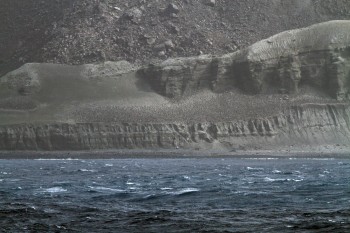
A Macaroni Penguin colony
McDonald Island is an active volcano, as is Heard Island. In recent years it is thought to have begun erupting in 1992, and has erupted several times since, notably in 1997. Satellite pictures from 1980 and 2001 show that the island had in that time period doubled in size from its originally estimated area of 1.13 to 2.45 km². These eruptions had joined Flat Island to McDonald Island by 1997. The last reported eruption was in 2005.
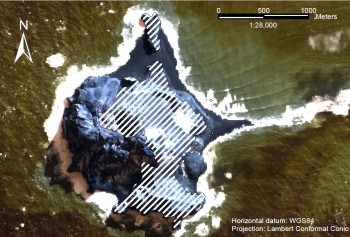
Island size before and after the eruptions
Two ACAP-listed species have been recorded breeding at the McDonald Islands. The 1980 visit yielded at least 78 Black-browed Albatross Thalassarche melanophris chicks on the southern cliffs of McDonald Island around Maxwell Hill and a further 11 on the upper slopes of Meyer Rock. A total of 800-900 Southern Giant Petrel Macronectes giganteus chicks was estimated to be present in March 1980 on McDonald Island, later estimated to represent 1400-1600 pairs. Their nest density in the main grassland area (10-15 ha) was estimated as 9-12 nests per 100 m². Previously, Southern Giant Petrels had been reported as breeding in their “hundreds” in the island’s centre that was vegetated with Tussock Grass Poa cookii and the cushion plant Azorella selago during the 1971 visit. The current status of both species on the McDonald Islands is unknown. The inland vegetation used for breeding by the latter species in 1980 is not thought to exist due to the recent volcanic activity, although Maxwell Hill appears to have survived. This has led to speculation of a displacement of giant petrels to Heard Island. During the 1971 visit a single Light-mantled Sooty Albatross Phoebetria palpebrata was recorded.
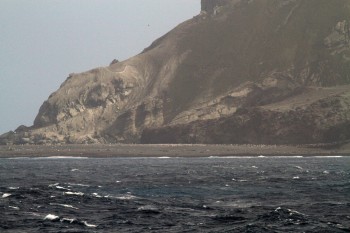
Phil Moors travelled on the m.v. Spirit of Enderby on an expedition led by Rodney Russ of Heritage Expeditions and viewed the McDonald Islands on 22 November 2012 from roughly 4 km off the east coast due to concerns over the possibility of uncharted rocks from recent volcanic action (click here). Sections of the island’s very large population (as many as one million pairs before the eruptions) of Macaroni Penguins Eudyptes chrysolophus as well as some King Penguins Aptenodytes patagonicus are just visible in his photographs.
King Penguins ashore
Photographs from the sea taken with a 400-m telephoto lens by Philip Moors
Click here to access the ACAP Breeding Site account for Heard Island.
With grateful thanks to Tess Egan, James Fleming, Margaret Koopman and Barbara Wienecke for information.
Selected references:
Australian Antarctic Division 2005. Heard Island and McDonald Islands Marine Reserve Management Plan. Kingston: Australian Antarctic Division. 198 pp.
Budd, G.M. 1972. McDonald Island reconnaissance, 1971. Polar Record 16: 64-67.
Budd, G.M. 1972. Breeding of the fur seal at McDonald Islands, and further population growth at Heard Island. Mammalia 36: 423-427.
Department of Sustainability, Environment, Water, Population and Communities 2011. National Recovery Plan for Threatened Albatrosses and Giant Petrels 2011-2016. Hobart: Commonwealth of Australia. 30 pp.
Jenkin, J.F. 1997. Vegetation of the McDonald Islands, sub-Antarctic. Polar Biology 18: 260-272.
Johnstone, G.W. 1982. Zoology. In: Veenstra, C. &, Manning, J. (Eds). Expedition to the Australian Territory of Heard Island and McDonald Islands. Technical Report No. 31. Canberra: Department of National Development and Energy, Division of National Mapping. pp. 33-39.
Keage, P.L. & Johnstone, G.W. 1982. Heard Island & the McDonald Islands. Australian Heritage Commission Newsletter 5: 4-5.
Quilty, P.G. & Wheller, G. 2000. Heard Island and the McDonald Islands: a window into the Kerguelen Plateau. Papers and Proceedings of the Royal Society of Tasmania 133(2): 1-12.
Stephenson, J., Budd, G.M., Manning, J. & Hansbro, P. 2005. Major eruption-induced changes to the McDonald Islands, southern Indian Ocean. Antarctic Science 17: 259-266.
Vandyke, I. 2013. Birding at the edge of the World. Australian BirdLife June 2013.
Woehler, E.J. 1991. Status and conservation of the seabirds of Heard Island and the McDonald Islands. In: Croxall, J.P. (Ed.). Seabird Status and Conservation: a Supplement. International Council for Bird Preservation Technical Publication No. 11. pp. 263-277.
Woehler, E.J. 2006. Status and conservation of the seabirds of Heard Island. In: Green, K. & Woehler, E.J. (Eds). Heard Island Southern Ocean Sentinel. Chipping Norton: Surrey Beatty & Sons. pp. 128-195.
John Cooper, ACAP Information Officer & Philip Moors, 25 August 2013

 English
English  Français
Français  Español
Español 